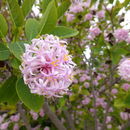en
names in breadcrumbs


Dais cotinifolia, known as the pompom tree, is a small Southern African tree belonging to the Thymelaeaceae family. It occurs along the east coast northwards from the Eastern Cape, inland along the Drakensberg escarpment through KwaZulu-Natal and the Transvaal, with an isolated population in the Eastern Highlands of Zimbabwe. It flowers profusely during the summer months and produces a multitude of pink, sweet-scented, globular flowerheads about 10 cm across. Depending on the circumstances it can reach a height of up to 12m, although it rarely exceeds 6m in cultivation.
Deciduous, bushy, with neat shape, its height and span only reaches 2-3m (in the UK).[1] It can reach up to 4 metres in Australia.[2] It has small ovate-oblong shaped and lustrous leaves.[1] It is evergreen in mild climates and deciduous in cool climates.[2] In spring,[2] or in the summer,[1] it bears scented star-shaped rose-lilac,[1] or pink coloured flowers,[2] in flattened clusters that are 8 cm wide across.[1]
Used as an ornamental in gardens,[1] can be grown as a small tree or multi-stemmed shrub.[2] It prefers siting in the garden in full sun and in fertile and well drained soils.[1][2]
Although, it's bark yields fibres that are strong enough to be used as thread.[1]
Dais cotinifolia, known as the pompom tree, is a small Southern African tree belonging to the Thymelaeaceae family. It occurs along the east coast northwards from the Eastern Cape, inland along the Drakensberg escarpment through KwaZulu-Natal and the Transvaal, with an isolated population in the Eastern Highlands of Zimbabwe. It flowers profusely during the summer months and produces a multitude of pink, sweet-scented, globular flowerheads about 10 cm across. Depending on the circumstances it can reach a height of up to 12m, although it rarely exceeds 6m in cultivation.